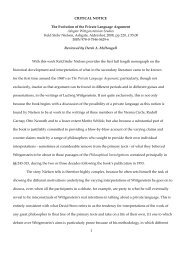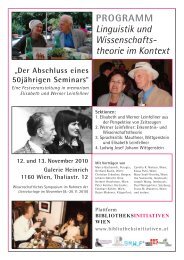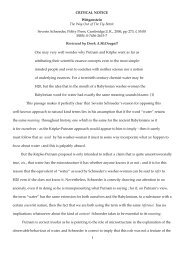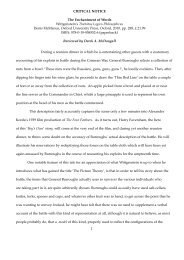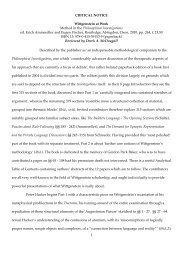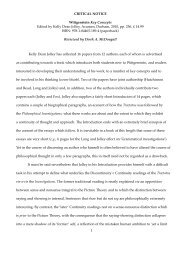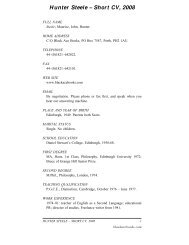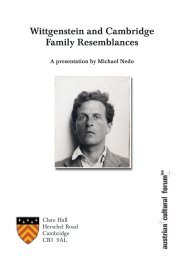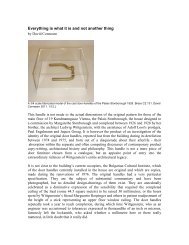Wittgenstein's Philosophical Investigations A Critical Guide
Wittgenstein's Philosophical Investigations A Critical Guide
Wittgenstein's Philosophical Investigations A Critical Guide
Create successful ePaper yourself
Turn your PDF publications into a flip-book with our unique Google optimized e-Paper software.
and so wrongly assimilates learning a first language to learning a second one (§ 32), by looking<br />
towards activities in which his subject displays a directedness towards things:<br />
For sure we can organise behaviour with respect to concepts, but<br />
can we not also organise behaviour with respect to objects ? We can<br />
attend to an object, lock on to the object and by so doing this attentive<br />
engagement shapes our options for further behaviour. When we do this,<br />
we act with a directedness with respect to the object, not to a concept.<br />
(Ibid., 37)<br />
In support of his idea, Luntley expresses a dislike for the ‘fantasy’ dubbed the ‘Augustinian<br />
Picture’ because, as he sees it, Wittgenstein has no genuine criticism of Augustine at all. Far from<br />
illustrating his possession of a ‘language of thought’, Augustine’s child is a subject who seeks,<br />
possesses, rejects and avoids things, a child who learns words in contexts in which his intentions<br />
and bodily movements are part of the natural language of all peoples by which they first express<br />
states of mind. By at least indirectly drawing our attention to a central feature of Wittgenstein’s<br />
thinking, one indicating that we directly experience another person’s anger, fear, or pain as painbehaviour,<br />
‘Augustine is articulating a piece of common sense that Wittgenstein famously explored<br />
and legitimized in his treatment of the relation of inner and outer.’ (Ibid., 40). Luntley’s Augustine<br />
has turned into Wittgenstein’s hero of the piece instead of into his villain.<br />
It is perhaps to be expected, therefore, that Luntley should see the builders in § 2 as<br />
agents who direct their behaviour towards things without exhibiting a capacity which is already<br />
conceptually structured (Ibid., 44), just as he takes the training in § 6 to involve the exercise of a<br />
capacity on behalf of an active agent to direct responses to things actively attended to. Training is not<br />
a form of stimulus-response conditioning in which pre-existing ‘causal wiring’ leads only to repeated<br />
causal regularities. Indeed, he disagrees with Meredith Williams over what he sees as her acceptance<br />
of precisely this model (1), one involved in her distinction between the roles she allocates to master<br />
and apprentice, where all the real work is effectively done by the teachers who, as it were, have<br />
8



